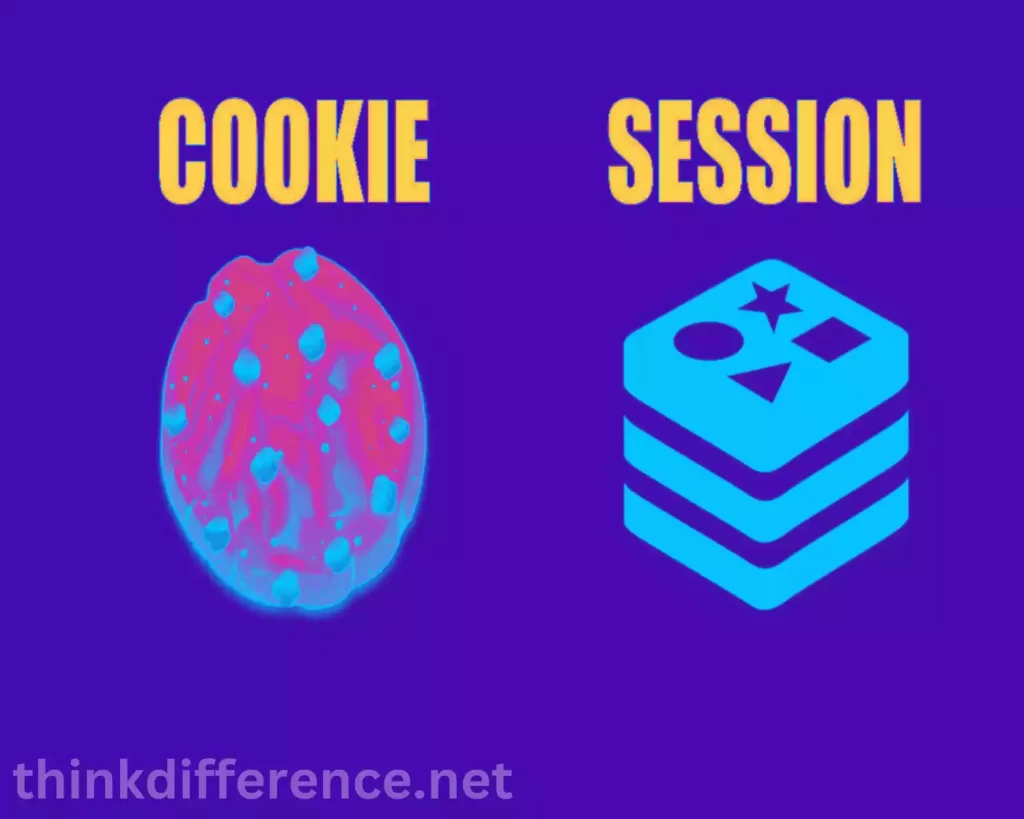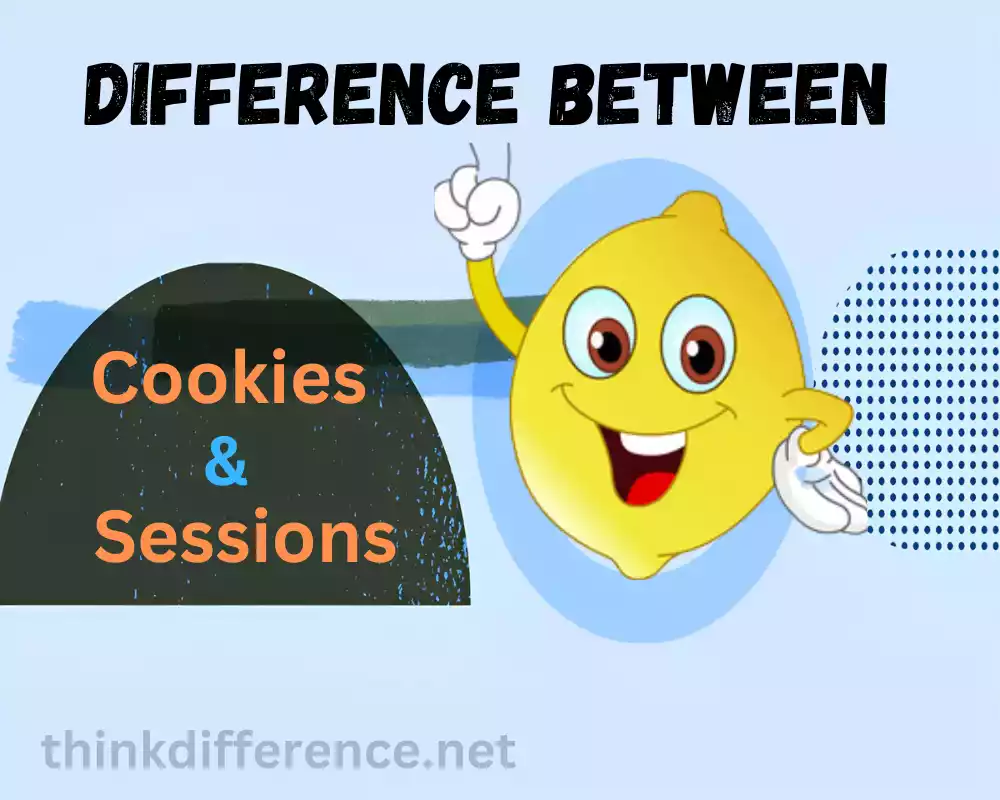Definition of Cookies and Sessions
Cookies: As soon as someone visits a website, small text files known as cookies are installed onto their device (computer or mobile phone) for use by websites to store and retrieve user browsing habits and preferences. Cookies enhance user experiences while providing personalized content delivery as well as certain website functionality.
Cookies are key-value pairs storing user preferences, session identifiers and shopping cart data. A website server sends cookies directly to each browser when visitors browse a site; once stored on their devices these will then return back to be delivered directly by browsers to websites every time the user returns – helping the latter recognize who their visitors are and personalize the experience accordingly.
Session cookies and persistent cookies are two main categories of cookies. Session Cookies are temporary files which will expire once a browser closes; these may store information such as login credentials and cart items for later. Persistent Cookies remain on a user device until expiring – they help track users over time as well as remember preferences.
Keep in mind that cookies cannot execute code or spread viruses – they’re meant to be safe. But they may present privacy issues by tracking users. Websites often offer cookie consent notifications as well as management or deletion options to users.

Sessions: Sessions refers to activities and interactions taking place between an application/website/service and its user in an allotted period of time, typically over an internet connection. A session provides a means by which stateful data can be maintained between client and server in web development projects.
An individual session begins when they visit any website, enabling the server to manage and track user activities. A unique ID generated by the server identifies this session ID which may then be stored as part of cookies or URL addresses – using it as an anchor point that links user requests throughout their stay at that particular site.
Session data refers to any information related to user interaction on a website and may include user preferences, form data submission information and the contents of an eCommerce shopping cart or authentication status. Session data differs from cookies in that its storage primarily occurs on server side rather than being kept as cookies are.
Cookies should not be confused with sessions; session data is held by the server and cannot be directly accessed by users. Sessions also feature timeout/expiration mechanisms which determine their duration; these timers could expire if no activity takes place for too long, necessitating either reauthentication or termination as necessary.
Sessions are used to maintain user login sessions, manage user-specific information and secure communication between a server and users. Cookies offer greater data protection; sessions allow more control. Their management can be complex in terms of scaling capacity and server resource optimization;
Cookies are frequently used to transmit the session ID between browser and server; this allows the latter to match user requests with session data. Sessions can also be implemented without cookies by appending session IDs to URLs or other means of data transmission.
Importance of understanding the difference between cookies and sessions
Understanding the distinctions between sessions and cookies can be vitally important, for multiple reasons:
- Functionality: Cookies and sessions both serve distinct functions and purposes for developers’ applications, so understanding these differences allows them to select the optimal mechanism based on each application’s individual requirements. It is key that developers implement features they desire such as personalization, data persistency and tracking users as part of any functional implementation strategy.
- Data Management: Cookies and Sessions take different approaches to data storage: Cookies are stored locally on user devices while sessions use server storage space to host information. Recognizing these differences between cookies and sessions is crucial in efficiently managing user privacy and protecting their security – considering issues like retention limits and meeting compliance regulations on data protection can impact either approach as a whole.
- User Experience: Cookies and sessions both play an essential role in optimizing the user experience of websites and web-based applications, from personalizing web pages and visits seamlessly across them to persistent logins and efficient browsing features. Understanding their differences allows you to optimize user expectations while tailoring it accordingly.
- Security: Both cookies and sessions have the ability to affect security in significant ways. Persistent cookies pose privacy concerns if they contain sensitive data that’s exposed, while sessions provide server-side controls and secure storage that lower the risk of sensitive information leaking out – understanding these differences allows developers to implement safeguards that ensure user data stays private.
- Development Considerations: Understanding the differences between sessions and cookies will enable developers to make better decisions during development, including decisions related to data storage, authentication mechanisms and server resources. Understanding them also makes troubleshooting session management issues, cookie handling and user tracking much simpler.
Understanding the distinctions between Cookies and Sessions is integral for making informed choices, implementing desired functionality, protecting user privacy and security, optimizing the user experience and efficiently managing data within web apps.
What is a Cookie?
Cookies are extremely small data files stored by websites on user computers (typically their web browser) which contain information regarding preferences and interactions with that particular website.

Here are some key points about cookies:
Purpose of Cookies: Cookies serve multiple functions, from improving user experiences and personalizing website content, to enabling specific functionality and tracking user activity and remembering preferences. They allow websites to measure traffic patterns more precisely while remembering user habits more easily.
Data Storage: Cookies are text files containing small bits of text with key-value pairs for data storage purposes, which include shopping cart contents, user preferences, session IDs and tracking info. They can store things such as cart items and preferences along with session IDs for tracking information purposes.
Storage Location: Cookies are stored within a user’s web browser and each one links back to a certain website; when making requests from this browser, that website sends back its respective cookie and can recognize and remember its user.
Types of Cookies:
- Session Cookies: Temporary cookies (sometimes referred to as session cookies ) are only stored temporarily in browser memory during your browsing session and then automatically delete after closing or switching websites.
- Persistent Cookies: Persistent cookies remain on a user’s device even after closing the browser, stored until their expiration date or until manually deleted by them.
Usage Scenarios:
- Remembering User Preferences: Cookies enable websites to remember user preferences such as language, user settings and custom content.
- Tracking and analytics: Cookies help companies gather data on user activity on a website as well as gain insight into improving its performance by tracking how a visitor behaves on it.
- Personalization and Login Credential Recall: Cookies can help remember login credentials as well as deliver personalized content tailored specifically for each user based upon user preferences.
Privacy and Security: Cookies can create security risks as they track user information and collect it. Many websites now provide consent notifications and give their visitors options on how they can manage or delete cookies from the website they’re on; in accordance with data protection laws and for user’s protection they should handle cookies with care in terms of data collection or collection and protection.
Cookies play an essential part in web browsing; they store and transmit data that enables websites to personalize user experiences, remember preferences and provide essential functionality.
What is a Session?
Sessions provide a logical link between server and user that maintains stateful information during multiple interactions over an agreed-upon duration period. Web development makes use of sessions for tracking users activities on websites.

Here are some key points about sessions:
- Initiation: An internet session begins when a visitor navigates a site to establish communication between his computer and server, creating a session ID (unique session identifier) for this individual user’s experience on that specific session.
- Server-Side Storage: Session information is typically kept on a server side rather than user devices; thus enabling an association of session data with their IDs.
- Data Persistence: Sessions are usually held open by servers for an established duration; their contents can be updated during that period and remain accessible during their lifecycle.
- Session ID: To uniquely identify each session, each session receives its own session ID which is then transmitted between browsers of users and servers through cookies to link user to data associated with that specific session.
- User Authentication: User Authentication Sessions provide the means for authenticating users. After signing into a system, a session ID is generated which can then be used in subsequent requests to verify an individual user. Users are thus granted access to protected resources without needing to reauthenticate.
- Session Information Storage: Sessions may contain user preferences, shopping cart content, form data and authentication status which is typically stored either on the server or persistent storage media associated with its session ID.
- Expiration or Timeout: Each session has an expiration date and time set into it, which allows if a user remains idle for too long (timeout), to expire and require them to either authenticate themselves again, or terminate it altogether for greater efficiency and security of server resources.
- Cross-Page Statefulness: Sessions allow the server to maintain stateful data across pages or interactions on a website, remembering user data and settings throughout their visit. The website remembers their information throughout.
Sessions are essential in managing user information, maintaining authentication status and customizing experiences on websites. Sessions enable servers to store and retrieve user-specific data with greater security and control than client-side storage mechanisms like cookies.
Differences Between Cookies and Sessions
Both cookies and sessions serve to enhance user experiences by managing user data effectively during web development, but each has distinct aspects to them that distinguishes between them.
Here are a few major distinctions between sessions and cookies:
- Storage Locations: Session data is typically saved on servers while cookies reside within web browsers.
- Cookies vary in terms of lifespan: Temporary ones expire once the browser closes; persistent ones remain on users’ devices even after browsers have been closed and sessions maintained by servers for an agreed-upon duration.
- Security Considerations: Because cookies are stored locally on users’ devices, they can be modified or accessed by third-party apps and the user alike. Therefore, session-based storage provides better protection and control.
- Scope and Accessibility: Cookies can only be accessed from specific websites within their domain; other domains also have access. Sessions on the other hand tend to be specific to how a user engages with one website – they cannot be reached from anywhere else on the internet.
- Dependency on Clients and Servers: Cookies depend on both devices and browsers used by a user in order to store and transmit information. In turn, session IDs stored on clients can identify individuals utilizing session data for session management purposes.
- Lifetime and Expiration: Cookie expiration dates and durations are controlled by websites or applications that issue them; session expiration times/timeouts can also be set by servers; once these have elapsed users might need to reauthenticate themselves or take other necessary actions in order to resume the session.
- Use and Scenarios: Cookies and sessions can both serve multiple functions for users: remember user preferences, track behavior and create tailored experiences. Session cookies enable authenticating users, maintaining information during sessions as well as secure communication between servers and their clients.
Developers need to understand these differences between mechanisms so as to select one suitable for specific use cases and implement this best approach to handle user data efficiently and improve user experiences across web applications.
Choosing Between Cookies and Sessions
When making decisions between sessions and cookies for user data management it’s crucial to keep several aspects in mind. Take these key components into consideration for an informed choice:
- Data Sensitivity: Evaluate the data’s sensitivity. Sessions may be appropriate for sensitive information like financial or user credentials that need to remain at the server; while cookies might work better when handling non-sensitive material like browsing histories and user preferences.
- Persistence Requirements: Deliberate on whether your data must persist after each session or visit. Cookies with long lifespan should be employed if the information must remain stored across several sessions. Shorter-lived session cookies or sessions would suffice if only data needs to remain for this specific visit or session.
- Storage Capacity: To determine your capacity requirements, think carefully about how much and the size of data will need to be stored. Cookies have limited space (up to 4KB per domain), whereas sessions have the capability of holding more information at any one time on a server and may therefore provide the solution if more storage space is required.
- User Experience: Think carefully about how cookies and sessions impact user experiences. Cookies allow for personalized experiences by remembering preferences and settings across visits; session sessions authenticate users on different pages so they stay logged-in throughout. Which approach would best benefit your user experience?
- Cross-Domain Compatibility: Cookies provide the easiest means of sharing data across domains and subdomains, being accessible across websites within one domain name itself. Sessions generally exist exclusively on one website and need extra setup in order to share data across domains.
- Scalability and Performance: When reviewing server resources and performance, keep multiple concurrent sessions in mind as their storage/management takes place on the server. Cookies may reduce server traffic but could possibly increase network traffic due to their cookie data storage requirements.
- Privacy and Compliance: Make sure your approach complies with any privacy or legal regulations applicable to your application, such as seeking user approval for cookie usage and using session management practices.
Cookies and sessions can work hand in hand; sessions provide the means for managing sensitive data securely while cookies store preferences that do not require authentication from users.
Careful consideration can enable you to select the appropriate mechanism (cookies or sessions) or combination for managing user data efficiently while meeting desired functionality and experience for your web app.
Conclusion
Cookies and Sessions are vital tools in the arsenal of web developers, empowering them to create personalized and functional web experiences. Cookies enable personalization, tracking, and shopping cart functionality, while sessions manage user-specific data during a browsing session.
By adhering to best practices and staying informed about emerging technologies, developers can harness the power of cookies and sessions responsibly, offering users the best of both worlds – enhanced user experiences and robust web functionalities.



